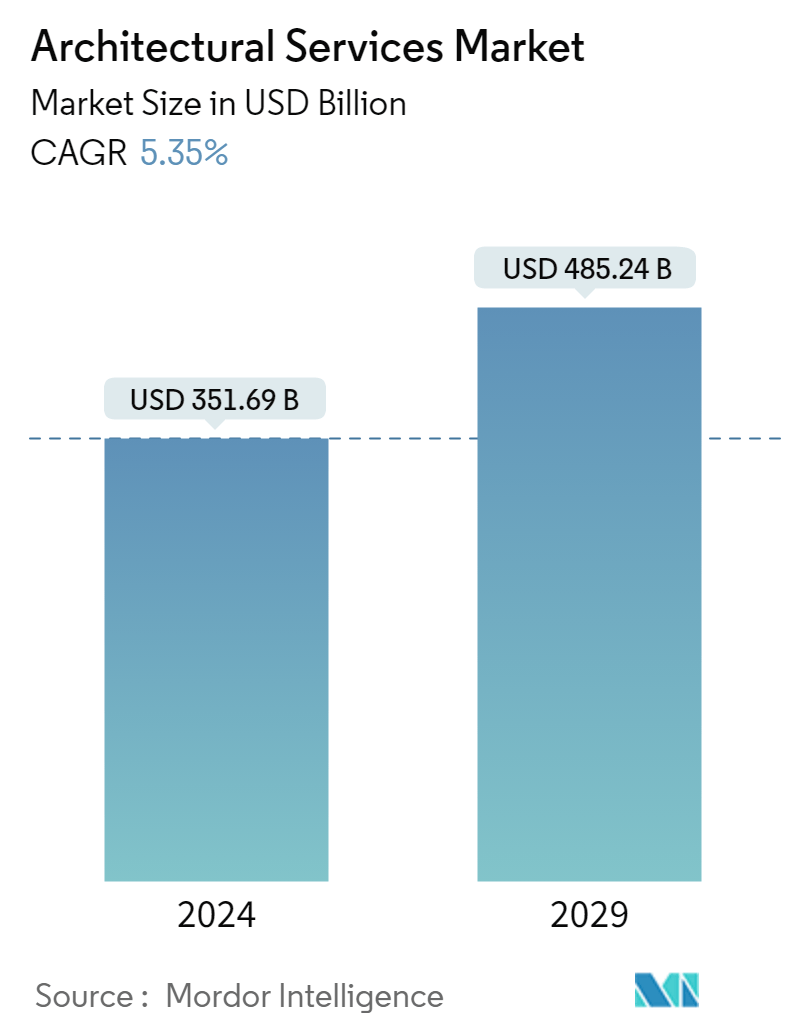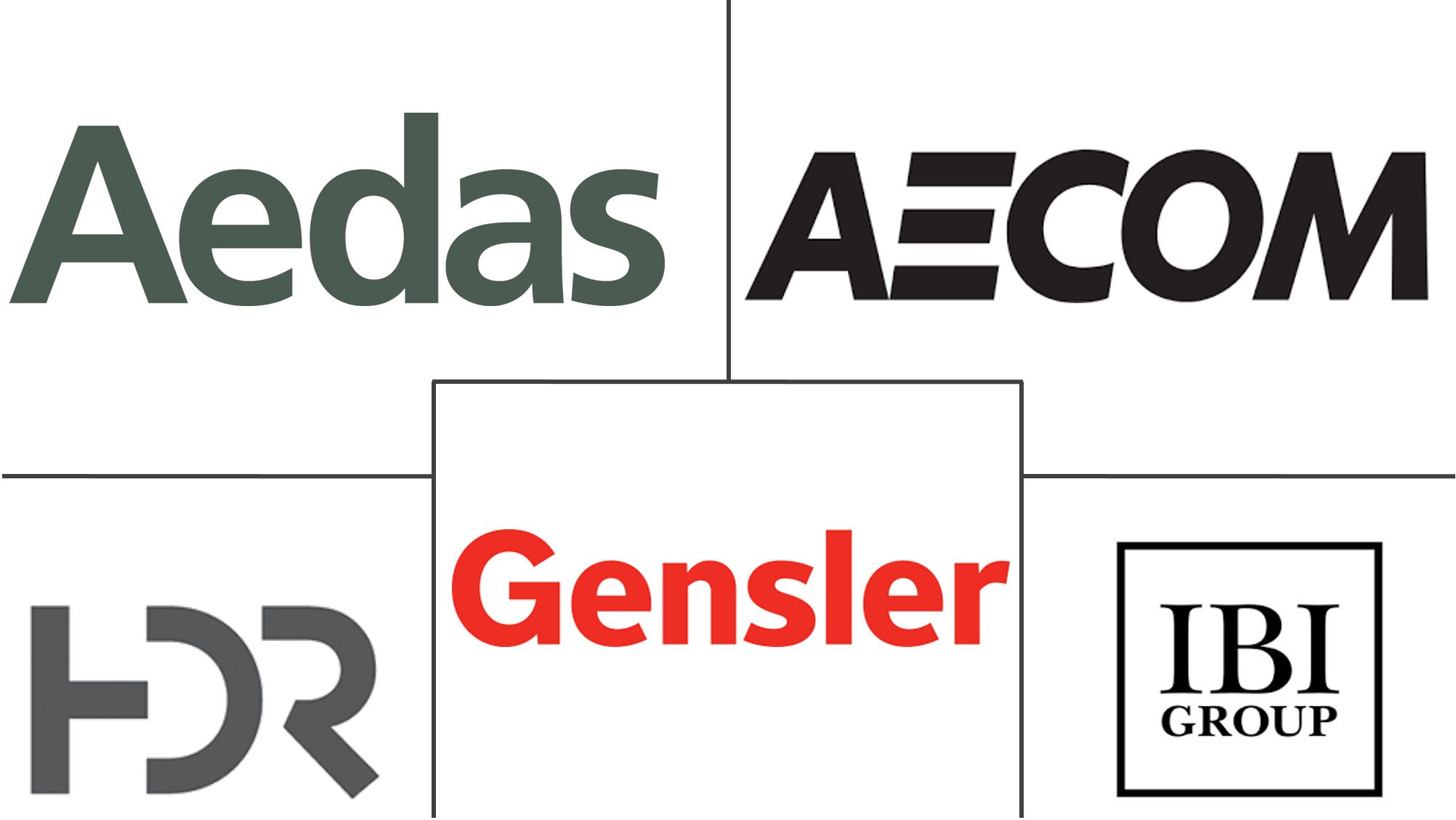Market Size of Architectural Services Industry

| Study Period | 2019 - 2029 |
| Market Size (2024) | USD 351.69 Billion |
| Market Size (2029) | USD 485.24 Billion |
| CAGR (2024 - 2029) | 5.35 % |
| Fastest Growing Market | Asia Pacific |
| Largest Market | Asia Pacific |
Major Players
*Disclaimer: Major Players sorted in no particular order |
Architectural Services Market Analysis
The Architectural Services Market size is estimated at USD 351.69 billion in 2024, and is expected to reach USD 485.24 billion by 2029, growing at a CAGR of 5.35% during the forecast period (2024-2029).
Architectural services offer feasibility studies, architectural programming, and project management, among others, with the aid of design, the creation of construction documentation, and the management of construction projects. Sustainable construction offers significant advantages and financial potential, pushing the market for architectural services. Additionally, increasing occupancy and the return on investment can reduce operational costs. The market is expanding due to the demand for conceptual engineering building construction and fundamental bioclimatic design.
- The advent of computer software has caused a paradigm change in architectural design during the past few years. Improvements in digital design tools, computer-controlled fabrication, connectivity, and interconnectedness have opened up a new stage of the design and build process.
- Building designs and architectural specifications constantly evolve due to the rapid infrastructure development in many growing nations. Furthermore, the demand for advanced design technology, such as 3D models and high-end designing software, is expected to rise as more and more new architectural firms enter the market with innovative designs and software, thereby improving services like urban planning. The architectural industry is also expanding significantly.
- The growing demand for green building services, which are intended to produce sustainable structures using ecologically responsible procedures and materials, is the fundamental force behind the growth of the architectural industry. Factors triggering global green building activity include market demands, the need to create healthier buildings, reduced energy consumption and lowering operating costs, environmental regulations, and local competition.
- The industry under study is expanding due to the rising popularity of 3D printing. This results from quick developments in material compositions, such as metals and polymers, as they transition from prototype tools to essential manufacturing components. This technology is also being incorporated into many processes and supply chains due to novel materials, reduced lead times, and unique finishes that abide by standards (FDA, ASTM, and ISO).
- The method used to tackle an issue demonstrates the nature of technology. Designing, then, might be characterized as a process that equally values problem-making and problem-solving. However, the technology's full potential cannot be realized without the knowledge and capacity to conceptualize design. The digital revolution in architectural design necessitates procedural and algorithmic thinking on the part of the designer as well as programming expertise. The design program is intricate and more challenging to utilize.
Architectural Services Industry Segmentation
The architectural services market study defines the revenues generated from services such as architectural advisory services, construction and project management services, engineering services, interior designing services, urban planning services, and other services deployed for various end users such as residential, education, healthcare, corporate, and other end users across the globe. The study includes qualitative coverage of the most adopted strategies and an analysis of the key base indicators in emerging markets.
The architectural services market is segmented by end user (residential, education, healthcare, corporate, and other end users) and geography (North America, Europe, Asia-Pacific, Latin America, and Middle East and Africa).
The market sizes and forecasts are provided in terms of value (USD) for all the segments.
| By End User | |
| Residential | |
| Education | |
| Healthcare | |
| Corporate | |
| Other End Users |
| By Geography | |
| North America | |
| Europe | |
| Asia-Pacific | |
| Latin America | |
| Middle East and Africa |
Architectural Services Market Size Summary
The architectural services market is poised for significant growth, driven by the increasing demand for sustainable construction and advanced design technologies. The industry is experiencing a transformation due to the integration of digital tools and software, which have revolutionized the design and construction processes. This shift has led to the adoption of innovative practices such as 3D modeling and computer-controlled fabrication, enhancing the efficiency and creativity of architectural projects. The market is further bolstered by the rising need for green building services, which focus on creating environmentally friendly structures that reduce energy consumption and operational costs. As urbanization and population growth continue to escalate, particularly in emerging markets, the demand for residential architectural services is also on the rise, with a focus on developing affordable housing and smart homes.
In the Asia-Pacific region, the architectural services market is expanding rapidly, fueled by government initiatives and a surge in urban development. The region's market is characterized by a high level of competitive rivalry, with numerous global and regional players vying for market share. Companies are increasingly forming strategic partnerships and mergers to enhance their service offerings and maintain a competitive edge. The market's growth is supported by venture capital investments, which facilitate the entry of new players and the introduction of novel designs and technologies. As the industry continues to evolve, the demand for high-end residential architecture services and advanced design software is expected to rise, providing ample opportunities for market participants to capitalize on emerging trends and consumer preferences.
Architectural Services Market Size - Table of Contents
-
1. MARKET INSIGHTS
-
1.1 Market Overview
-
1.2 Industry Value Chain Analysis
-
1.3 Industry Attractiveness - Porter's Five Forces Analysis
-
1.3.1 Bargaining Power of Suppliers
-
1.3.2 Bargaining Power of Buyers/Consumers
-
1.3.3 Threat of New Entrants
-
1.3.4 Threat of Substitute Products
-
1.3.5 Intensity of Competitive Rivalry
-
-
-
2. MARKET SEGMENTATION
-
2.1 By End User
-
2.1.1 Residential
-
2.1.2 Education
-
2.1.3 Healthcare
-
2.1.4 Corporate
-
2.1.5 Other End Users
-
-
2.2 By Geography
-
2.2.1 North America
-
2.2.2 Europe
-
2.2.3 Asia-Pacific
-
2.2.4 Latin America
-
2.2.5 Middle East and Africa
-
-
Architectural Services Market Size FAQs
How big is the Architectural Services Market?
The Architectural Services Market size is expected to reach USD 351.69 billion in 2024 and grow at a CAGR of 5.35% to reach USD 485.24 billion by 2029.
What is the current Architectural Services Market size?
In 2024, the Architectural Services Market size is expected to reach USD 351.69 billion.

